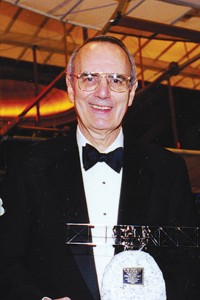 Ambassador Edward W. Stimpson led the general aviation industry during one of the most dynamic times in aviation history.
Ambassador Edward W. Stimpson led the general aviation industry during one of the most dynamic times in aviation history.
In July 1999, President Bill Clinton appointed Stimpson as the U.S. representative on the Council of the International Civil Aviation Organization. He assumed his duties that October with the specialized agency of the United Nations that sets world standards for 185 nations in the areas of air safety, navigation, environment and security.
Stimpson was highly involved in the expansion of the organization’s aviation security program. In addition to representing the U.S. on the 36-member council, he led delegations to dozens of international meetings, including three ICAO assemblies. He retired in December 2004.
Not only did he lead the General Aviation Manufacturers Association for 25 years, but he was also instrumental in representing the interests of the United States following the 9/11 attacks.
“We will have to address this problem together because this is a completely new world with new threats and new dynamics. We are confronting things we haven’t even thought about before, let alone discussed,” Stimpson said about the challenges he faced in leading America’s aviation community into a new era.
A native of Bellingham, Wash., Stimpson received his bachelor’s degree in government from Harvard College in 1956, and a master of public administration from the University of Washington in 1959. He met his wife, Dorothy, at the Seattle World’s Fair in 1962. At the time, Stimpson was acting director of the Pacific Science Center Foundation, where he developed the concept of converting the U.S. Science Pavilion at the event into a permanent science center.
That same year, he joined the Federal Aviation Administration. Named the assistant administrator for congressional liaison in 1965, he advised the FAA administrator on all phases of congressional activity.
In 1970, he started with GAMA. Alongside industry leaders like Cessna’s Russ Meyer, he worked relentlessly for passage of the General Aviation Revitalization Act. As Stimpson pointed out, before the 1994 law was passed, had a pilot crashed the Wright Flyer, he could have sued the Wright Brothers for design defects over 90 years later.
In 1996, he became vice chairman of the organization and also led its “Be A Pilot” program, the largest industry-wide effort in history to encourage more people to learn to fly. His experience included leading trade missions for the U.S. Department of Commerce, chairing NASA’s Task Force on General Aviation Technology, and serving on the FAA’s Research and Development Advisory Committee.
For more than 20 years, he was on the board of Embry Riddle Aeronautical University. He played an active role in the university’s growth and the international expansion of aviation education.
His honors include the FAA’s Meritorious Service Award and its Decoration for Exceptional Service and the Wright Brothers Memorial Trophy. The National Aeronautic Association selected him among its recipients of its 1997 Elder Statesmen of Aviation Award.











